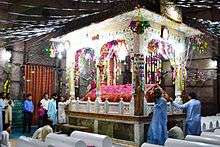Rukn-e-Alam
| Rukn-ud-Din Abul Fateh رکن الدین ابوالفتح | |
|---|---|
 | |
| Religion | Islam, specifically the Suhrawardiyya Sufi order |
| Other names | (Shah) Rukn-e-Alam |
| Personal | |
| Born |
1251 Multan, Punjab |
| Died |
1335 Multan, sindh |
| Senior posting | |
| Based in | Multan, Punjab |
| Period in office | 13th/14th century |
Sheikh Rukn-ud-Din Abul Fateh (Persian: رکن الدین ابوالفتح), commonly known by the title (Shah) Rukn-e-Alam ("Pillar of the World") (1251–1335), was an eminent Sufi saint from Multan in modern-day Pakistan who belonged to Suhrawardiyya Sufi order.
Biography
Shah Rukn-e-Alam was the son of Pir Sadar-Al-Din Arif. He was born in Multan on Friday, the 9th of Ramadan 649 Hijri (26 November 1251).[1] He was the grandson and successor of Sheikh Baha-ud-din Zakariya.
Shah Rukn-e-Alam died on Friday, the 7th of Jumada al-awwal 735 Hijri (3 January 1335). He was buried in the mausoleum of his grandfather, according to his own will. After sometime, however, his coffin was transferred to the present mausoleum. Shah Rukn-e-Alam never married. He regarded the children of Sheikh Hameed ud Din al Hakim as his own children and said that people will remember his name through Hakim's generations. Upon his death, Shah Rukn-e-Alam conferred his spiritual succession to Sheikh Hameed ud Din al Hakim, buried at Mau Mubarak in Rahim Yar Khan, who was his Ataleeq-e-Awwal, Khalifa-e-Awwal and was married to his aunt, the daughter of Sheikh Baha-ud-Din Zakariya.
Mausoleum
The saint is still revered today and his tomb is the focus of the pilgrimage of over 100,000 pilgrims from all over South Asia.[2] Makhdoom Shahabuddin who is the Sajjada Nashin of Sheikh Hameed ud Din al Hakim is also the current Sajjada Nashin and custodian of the Mausoleum of Shah Rukn-e-Alam.[3] The tomb was built between 1320 and 1324 CE in the pre-Mughal architectural style. The tomb is said to have built by Ghias-ud-Din Tughlak (r.1320-1325 AD) during his governorship of Depalpur, between 1320 and 1324 CE and was given by his son, Muhammad bin Tughluq to the descendants of Shah Rukn-e-Alam for the latter’s burial in 1330. In the 1970s, the mausoleum was thoroughly repaired and renovated by the Auqaf Department. The entire glittering glazed interior is the result of new tiles and brickwork done by the Kashigars of Multan.[4]
The tomb is on the tentative list as a UNESCO World Heritage Site.[5]
Memorandum
- Shah Rukan e Alam, named after the saint, is one of the autonomous towns of the city of Multan.
- A daily train service, Shah Rukn-e-Alam Express, between Multan and Karachi was named after him. It was suspended on February 2011 due to lack of locomotives. [6]
Followers' Slogans
نوري حضوري رڪن عالم رح
ڪر آس منهنجي ب پوري
See also
Notes
- ↑ Historic Multan Government of Pakistan
- ↑ Over 100,000 pilgrims as visitors UNESCO World Heritage
- ↑ Mausoleum of Shah Rukn-e-Alam "Multan City Online"
- ↑ http://www.heritage.gov.pk/html_Pages/historic_multan.htm Historic Multan
- ↑ http://whc.unesco.org/en/tentativelists/1884/
- ↑ More trains may be suspended Publisher: Dawn News. Published on 2 February 2011. Retrieved on 27 May 2013

